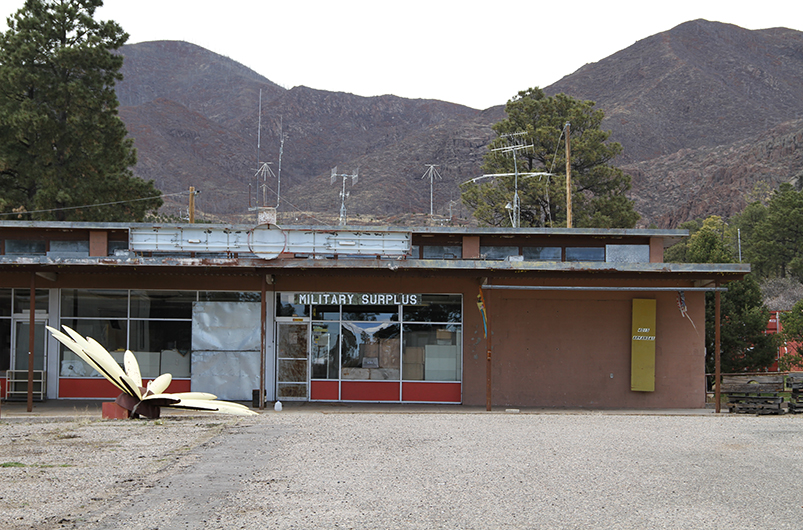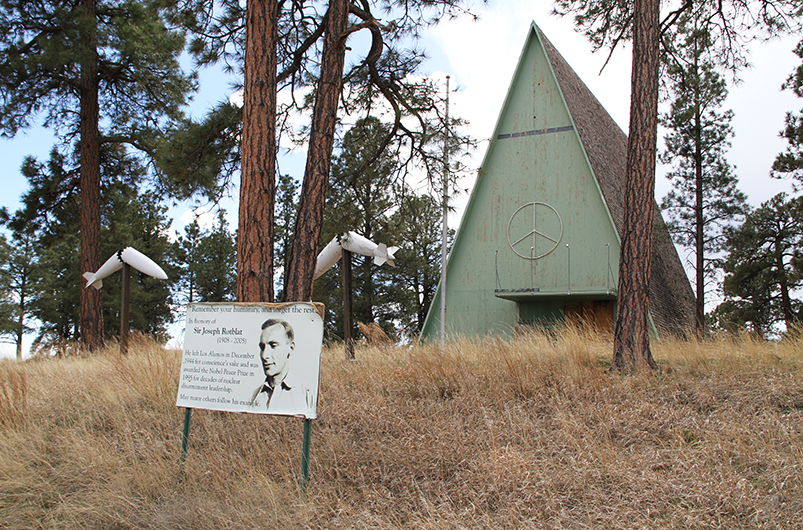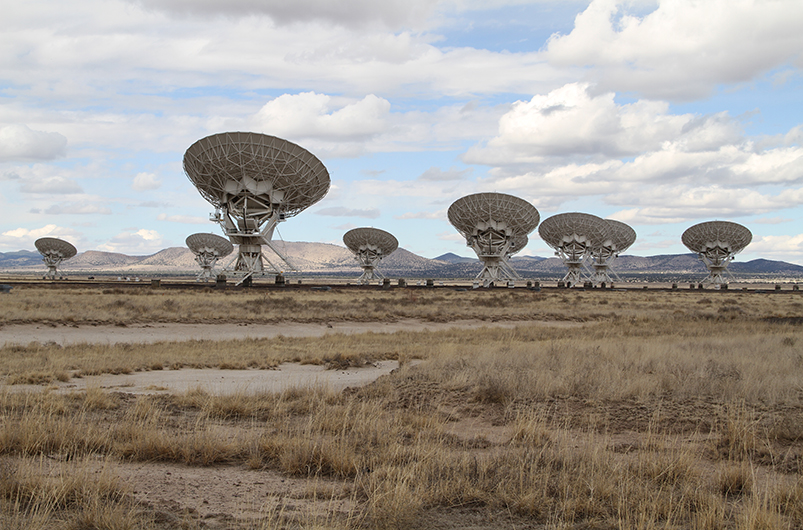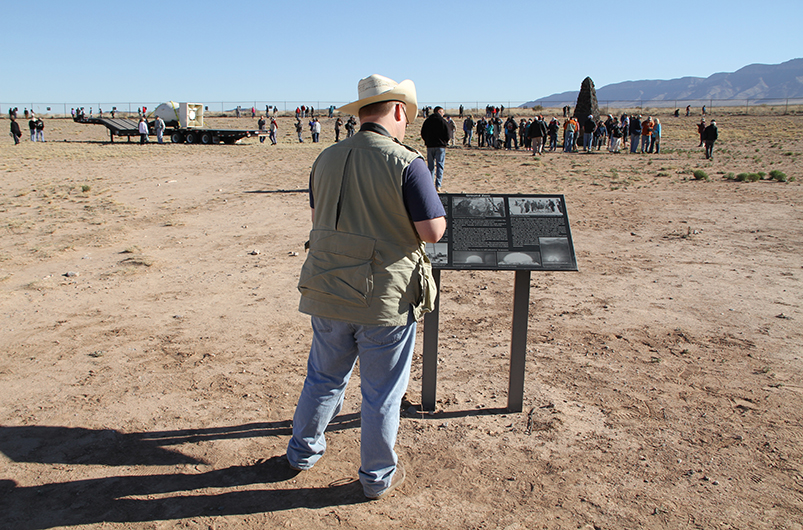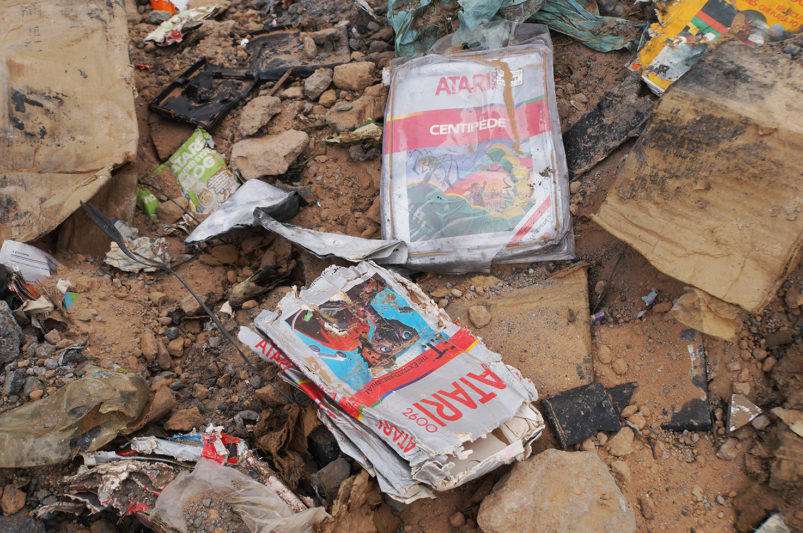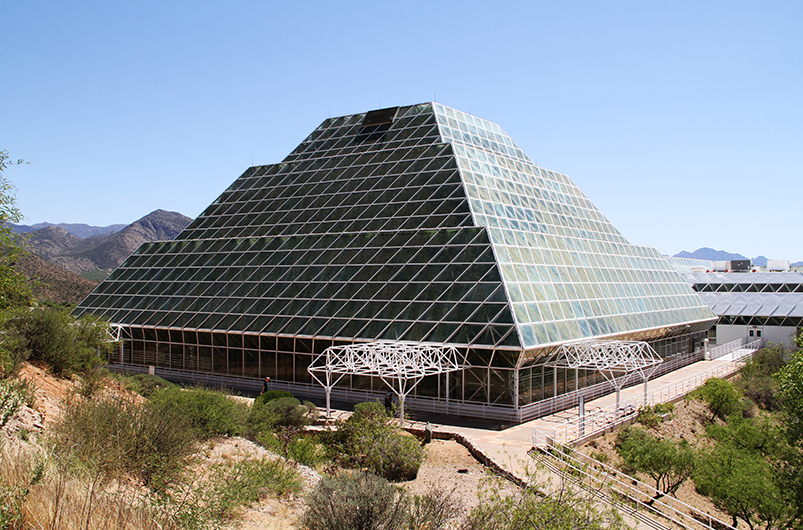Space Trailing USA

White Sands Missile Range, New Mexico, US
The last part of my residency in the Southern States consists of a road trip through New Mexico and Arizona to look for remnants of the coinciding Space Age, Atomic Age and Computer Age. I fly to Albuquerque where between 1975 and 1979 Microsoft build the foundations for the computer revolution that would transform the world and the way we live beyond recognition. But the story starts earlier. Inherently connected to the development of the first computer was the attempt to decipher Germany’s secret codes during the World War II. The fear of the Germans creating a new bomb by splitting atoms, fueled the American desire to be the first to obtain this unprecedented power. After the capitulation of Germany in 1945, many German scientists working on the V2 rocket program were incorporated in the Manhattan project, and later on helped in the space program, that was depending on the captured German V2 rockets. First, me and Marjolijn Dijkman (who came over to join me on this space trail adventure) go to the Nuclear museum in Albuquerque that exhibits models of The Gadget, the first atomic bomb that was detonated on a site called Trinity, near Alamogordo, New Mexico on the 16th of July 1945, and Little Boy and Fat Man, the two atomic bombs that were dropped on Nagasaki and Hiroshima in Japan a few months later. In the museum there is a map that shows the percentage of Uranium that is mined in different countries. D.R. Congo is not present, although Uranium from the Shinkolobwe mine accounted for the large majority of the needed material to create both The Gadget, Little Boy and Fat Man. Without the Uranium from D.R. Congo there would not have been such an ‘early’ success in the Manhattan project. In the entire museum, only in a letter of Einstein, the most rich Uranium mine in the world (located at that time in Belgian Congo) is mentioned. I hope that the reason for not including D.R. Congo, is international security (the Shinkolobwe mine is not (well) protected and small shipments of illegally mined Uranium are frequently intercepted), instead of a global conspiracy to make sure that D.R. Congo doesn’t develop itself into potentially the most wealthy and powerful nation on the planet (sic).
The next day we go to Los Alamos, the city that wasn’t there. One-hour drive from Albuquerque, a new and secret city was build for the Manhattan project. Most of the inhabitants did not even know what they were working on. Only a hand full of people got the entire picture. Today, the whole facility is gone, what remains are a few houses from key figures that lived there during the development of the atomic bomb. Everything else is a new city with new houses and new inhabitants. We drive up to the Black Hole, a thrift store that bought up all the remaining equipment from the Manhattan project. On arrival, the site looks abandoned. A man walks to his car in front of the gate and as we approach he hesitates to get in, since we are clearly in the wrong place. There is nothing else to be seen close by that could explain why alien tourists are approaching the gate. I ask him if he knows about the place and if it is still open. He says he is the owner and sold all the remaining material 4 months ago. ‘The website should have been taken offline long ago’, he groans, ‘because people keep coming’. I’m clearly disappointed and tell him I came all the way from Belgium to visit his shop and the more I tell him about my intentions the more I see him hesitate. ‘But what are you looking for?’, he wants to know as he slowly warms up to me. I tell him I’m an artist and I don’t know what I’m looking for. Just anything that has a certain form or function that could inspire me to make a new work with. I clearly hit the right button, since he made some artistic work himself. ‘Do you see that white container there? Everything that is left over is in there’ he says while we walk over to the door. ‘There are no stairs so you should climb in’, he adds while he opens the lock of the heavy door. ‘You have 30 minutes. Take whatever interests you and put it in the door opening. We’ll make a deal afterwards, cash only.’ I cannot believe my ears, and even less my eyes, when I enter the container: the last remnants of the Manhattan project, piled up in shelves and boxes, one big mess of treasures. I feel like Indiana Jones discovering the Holy Grail! I’m not sure how this adventure will end and how much value he thinks these last remnant have, so very carefully I select some objects and put them in the door opening, also considering the fact that I still need to be able to ship them home. After half an hour he comes back and we decide on a very reasonable price (we’re both happy, let’s keep it at that). He urges me to ship the stuff and not try to take it with me on the airplane. I will only fully understand his concern when I fly back home, but that is for later.
First we visit the Very Large Array (VLA), an iconic collection of satellite dishes that became world famous thanks to the film ‘Contact’ with Jodie Foster as leading actress listening to the skies to hear messages from Extraterrestrial life. SETI (Search for Extraterrestrial Life) research was never done here, although the site will always be connected to that field of study. VLA is used by astronomers to make key observations of black holes and magnetic filaments, and to probe the Universe's cosmological parameters. The sky turns dark as we hit the road again. Something is coming…
It is the first Saturday of April, one of the only two days that the Trinity site is open to the public, so at 8am I drive up the road leading to the Stallion Gate and hit a traffic jam. Hundreds of people had the same idea and form a snake to be able to visit one of the most problematic tourist destinations. Once we are allowed to drive through and are thoroughly checked, we form a line of curious visitors as we near the site. The parking is already packed, coffee is served and before 9am the first sausages and hamburgers are ready on the bbq. On foot, or some fat examples of the American sub-species Homo Hamburgerensis, by golf cart, we march the last mile to the monument, a rough-sided, lava-rock obelisk of 3,7 meter high, erected in 1965 in the center of the site itself. The gentle remaining valley is encircled by a fence, after the initial crater has been cleaned and filled up. Outside nobody is allowed. First hundreds and than thousands of people flock around the small monument, posing and smiling in front of it. A sign on the fence states that it is a federal crime to take anything from the site, so as all the other collecting treasure hunters we absolutely do NOT take any Trinitite from the site. Especially not from the far edges on the right and left, close to the fence. Due to the enormous heat of the explosion, the sand was transformed into a greenish glass like new substance, which was called Trinitite, or Alamogordo glass. Outside the site itself, several people sell the stuff from their car in self-made shops. They position themselves opposite the so called ‘Downwinders’, a group of furious descendents of the +/- 50.000 people who lives in the area surrounding the test site that was supposedly free of people. Many of them died of cancers and other diseases and passed it on to their children and grandchildren. In the morning of the explosion children ran outside to play in what they thought fresh snow, and rubbed it in their faces. Contrary to the ‘Downwinders’ of the new test site in Nevada and other atolls in the oceans, which were present in a much larger safety perimeter, the survivors of the Trinity test never received recognition or compensation.
We drive up to Alamogordo, the city that is forever linked to the first atomic bomb and also the place where a major myth of computer history was proven true. After the bankruptcy of Atari, a pioneer in arcade games, home video game consoles, and home computers, truckloads of games, and most notoriously E.T. the Extra-Terrestrial, that according to some legends caused Atari to get bust and features in many list as the worst game ever made, were buried in a landfill in Alamogordo. After several years of research and convincing, digging started on a specific location that was the most likely to contain these fetishised contemporary archaeological treasures. People from all over the United States came over to witness and be part of this very recent and remarkable historic event. In April 2014, the first games were discovered. Nearly 900 E.T. games were salvaged from the dump and the city wrapped and labeled the majority and sold them on e-bay for over 100.000$. Today they are still for sale for up to 1000$ a piece. A beautiful example of contemporary archaeology in the present day geological garbage layer we keep adding in an unproven attempt to manufacture a new geologic era, the Anthropocene, the Age of Man.
On the way to Arizona, we stop briefly at the White Sands National Monument, the largest gypsum dune field in the world, and the White Sands Missile Range, the largest military installation in the United States that also includes Trinity Site. Both are part of the Chihuahuan desert that straddles the Mexico-US border. The sun is high up in the noon sky and the reflecting light is almost as intense as a nuclear explosion.

White Sands National Monument, New Mexico, US
Next stop is Biospere 2 in Oracle, Arizona, the most spectacular experiment to survive in a closed environment, possibly on another planet. Financed by billionaire Ed Bass, and finished 1991, the structure was inaugurated when 8 people (four women and four men), entered with the idea to survive inside for two years, surrounded by samples of all climatologically different environments on Earth. After 16 Months, the oxygen level was so low that they had to open the windows. Apparently the outburst of the Pinatubo volcano in 1991 caused the amounts of sun-hours to decline to such a degree that the nutrition was at an all-time low and photosynthesis was stalling. On top of that they discovered that the concrete that was used to build artificial rock formations was absorbing more Co2 than anticipated, which proved to be a very important discovery late on, but at the time a very catastrophic coincidence. The experiment was considered a failure in the disaster-addicted media, but was an incredible success in the scientific world. The site is now used by the University of Arizona to do supplementary research on pollution and natural productivity and resilience in an enclosed environment.
In Flagstaff, Arizona, we visit the Lowell Observatory, an iconic place where the beautifully restored and preserved Lowell telescope has been made visible to the public. The astronauts of the Apollo missions came here to train and pick a landing spot on the moon, and between 1912 and 1914, large recessional velocities of galaxies were discovered that ultimately led to the realization that our universe is expanding. In 1930 Pluto was discovered in the Lowell telescope.
After a tour through the telescope we are guided to the Rotunda Museum where a document mentions the role of the Lowell family in the development of the cotton industry. Francis Cabot Lowell is even considered as the father of the Industrial Revolution in the United States and a town in Massachusetts is even named after the family. I ask the guide what the role was of enslaved people in the development of the wealth of the Lowell family and thus the creation of the Lowell Institute and the Lowell chair/room at Harvard. She is shocked but intrigued and promises me to look into it. Before the end of the tour she ran into the offices to talk to a colleague of hers who reacted apparently in the same way but nevertheless dug up two books that might help in this important quest. Very sensitive matter... If you google however 5 minutes into the history of the Lowell family, it will be hard to maintain that they had nothing to do with slave trade or that their wealth did not come about thanks to the slave labor of African Americans. They should at least acknowledge that in their Rotunda Hall of Fame and give credit to all parties involved.
Slowly making our way back to Albuquerque, we stop at Meteor Crater (or Canyon Diablo Crater), the best preserved and first officially recognised meteor crater in the world. The meteorites found around the crater helped to determine the age of life on planet Earth, but before they were proven genuine, the majority was melted into railroad tracks to conquer the Wild West. Somewhere in the United States you can travel by train over several miles of melted meteorites. One day, meteorites might prove to have brought life to our planet, finally solving the long mystery about the origin of life. We might be the Aliens we are looking for and we landed on earth already a long time ago.
We pass through Petrified Forest National Park, a truly magnificent place with landscapes that seem to have escaped from another planet. As the name suggests already the place is packed with petrified trees, mostly spread out in bits and pieces, logs left on the ground after a chainsaw massacre. The growth rings are still visible but they turned purple, green and yellow. The blue and purple clay layer that covers them is washed down by the rain and unearths more and more trees, still causing the petrified forest to grow year after year. Sometimes the trees stayed intact after the mudslide down, making them indistinguishable from the wooden tree they once were. Messages carved in stone tell of the importance of the location for ancient civilisations and there are even some (reconstructed) settlements build with stone logs creating a beautiful symbiosis between the two most used building materials known to man. The fee area of the park is 440 km2, big enough to spend the whole day there easily, but it is time to get back and start packing for the return trip that will prove to be an adventure on itself.
I manage to ship most of the material I bought in the Black Hole, wrapped in the cotton I got in Memphis, but since I’m not sure the package will arrive, I decide to take two massive glass lenses in my luggage. At the check in my suitcase is way to heavy so I need to shift some stuff into my carry on luggage. Since the lenses are quite heavy I decide to divide the weight and take one in my backpack. The security scanner gives an instant alarm, so I’m taken aside. A small toothbrush size sensor is stroked on the edges of my backpack and used as a probe to sample the contents. Again high alert. The security officer takes out the content but has a special interest for the lens that is checked separately this time. WIUUUUU WIUUUUU!!! She calls her supervisor to repeat the test. WIUUUUU WIUUUUU!!! They know what it means, since the scanner is used to find traces of explosive materials, but they don’t understand why a simple glass lens is creating this upheaval. I just play dumb but can’t help thinking: COOL! This really proves that the stuff I got is the real deal!
Uncertain what to make of it and blaming the curved glass for the anomaly, they let me go. What a relief. It takes a few more weeks for the package I send by mail to arrive, but it includes everything I packed. I just need to pay an additional fee (on top of the ridiculously high shipping price) for special customs check where they probably scratched their heads in the same way as they did at the airport. Enough traces of explosives and/or uranium to check the contents, but not enough proof of criminal wrong-doing or intent to confiscate it. Everything arrived safely in my atelier, the cherry on a very fruitful and productive research trip. Thank you!


